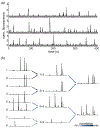Coarse Graining, Fixed Points, and Scaling in a Large Population of Neurons
- PMID: 31702278
- PMCID: PMC7335427
- DOI: 10.1103/PhysRevLett.123.178103
Coarse Graining, Fixed Points, and Scaling in a Large Population of Neurons
Abstract
We develop a phenomenological coarse-graining procedure for activity in a large network of neurons, and apply this to recordings from a population of 1000+ cells in the hippocampus. Distributions of coarse-grained variables seem to approach a fixed non-Gaussian form, and we see evidence of scaling in both static and dynamic quantities. These results suggest that the collective behavior of the network is described by a nontrivial fixed point.
Figures





References
-
- Kadanoff LP, Physics 2, 263 (1966).
-
- Wilson KG, Rev. Mod. Phys 47, 773 (1975).
-
- Wilson KG, Sci. Am 241, 158 (1979).
-
- Cardy J, Scaling and Renormalization in Statistical Physics (Cambridge University Press, Cambridge, England, 1996).
-
- Segev R, Goodhouse J, Puchalla JL, and Berry II MJ, Nat. Neurosci 7, 1155 (2004). - PubMed
MeSH terms
Grants and funding
LinkOut - more resources
Full Text Sources
